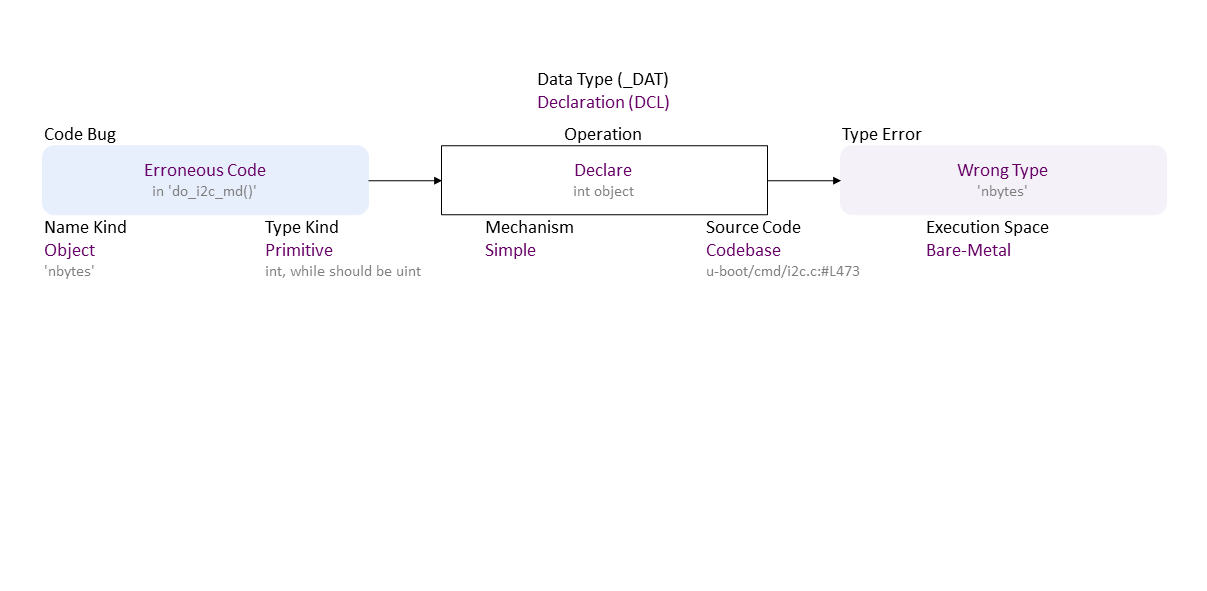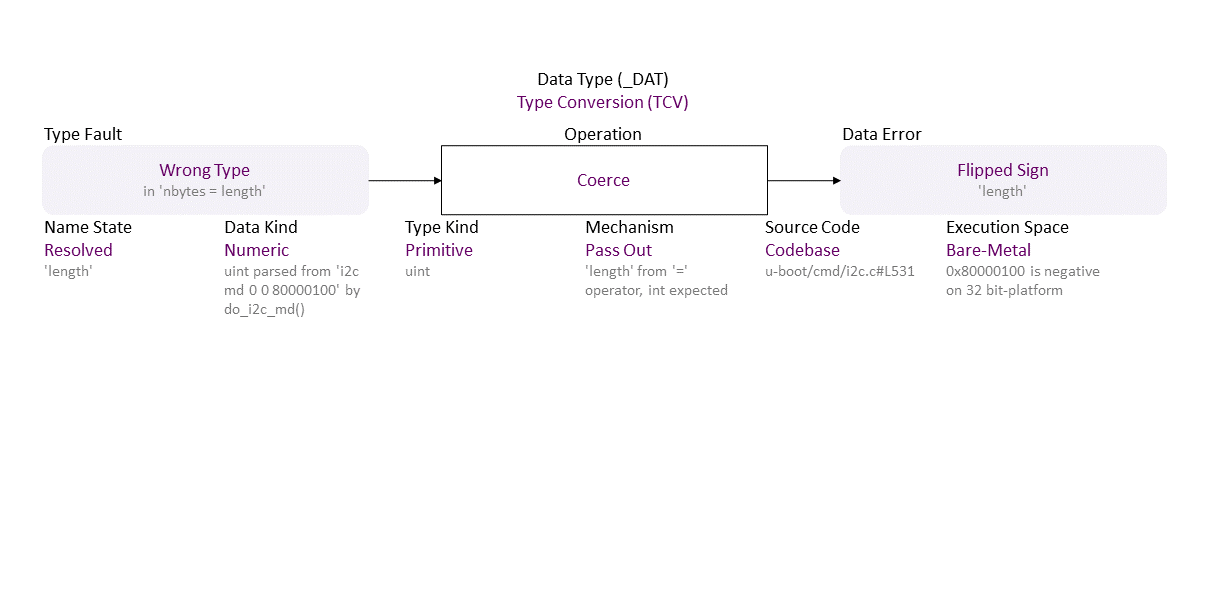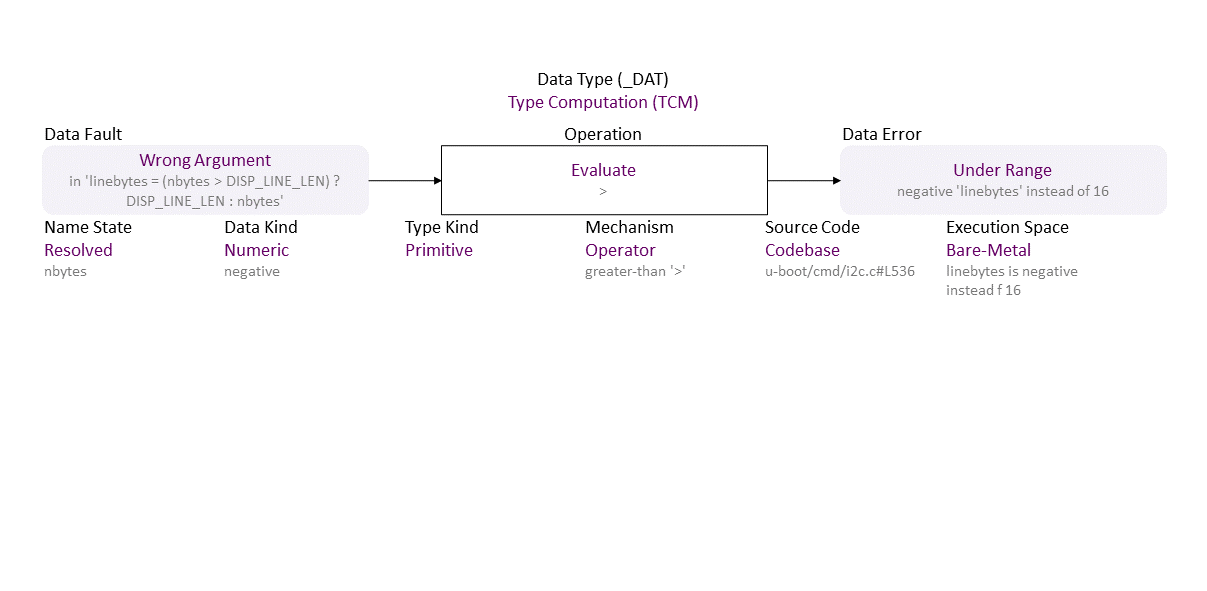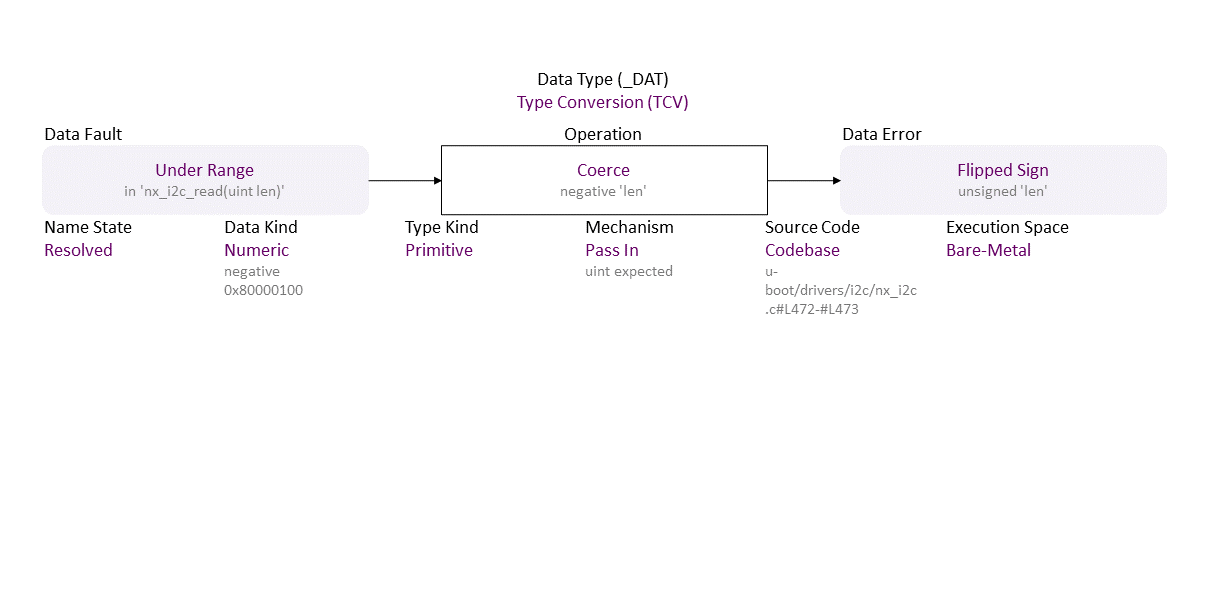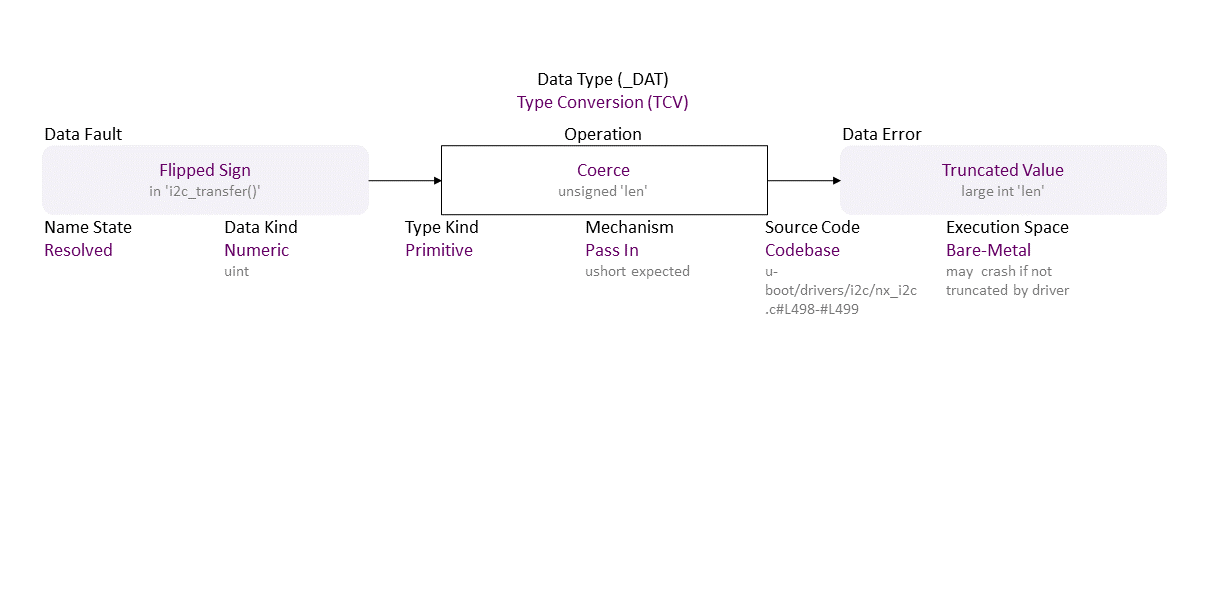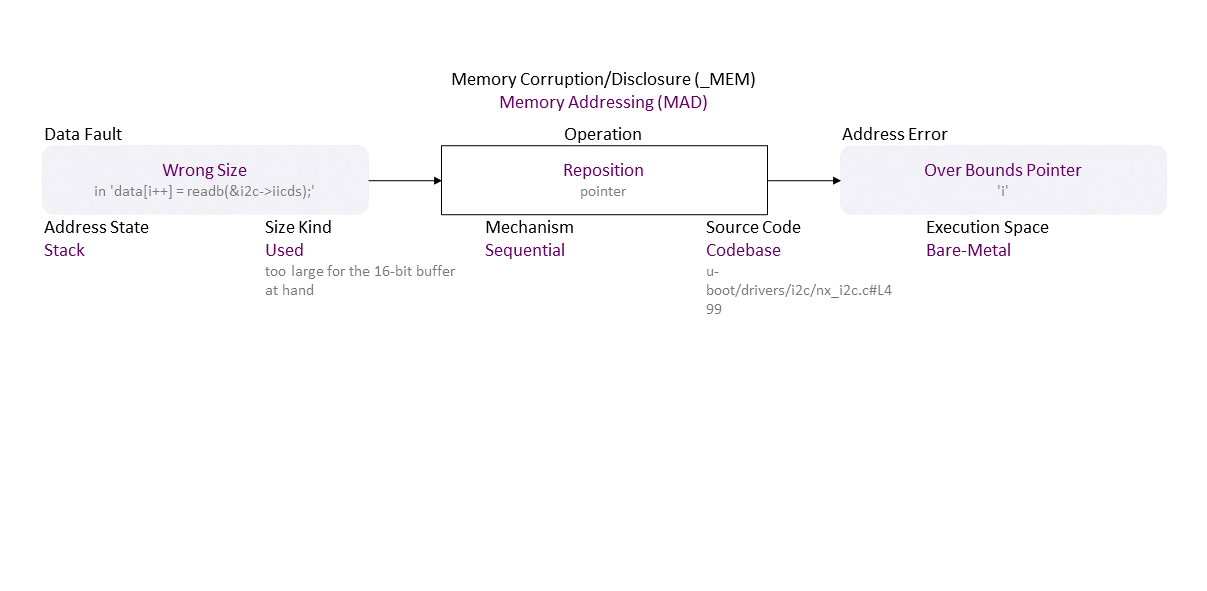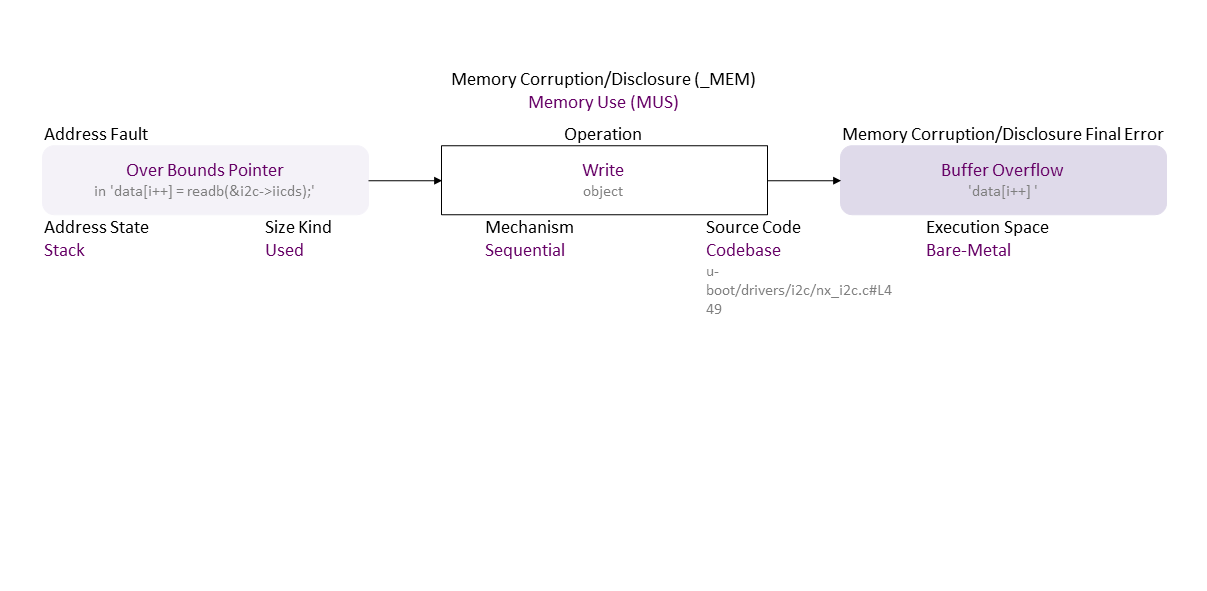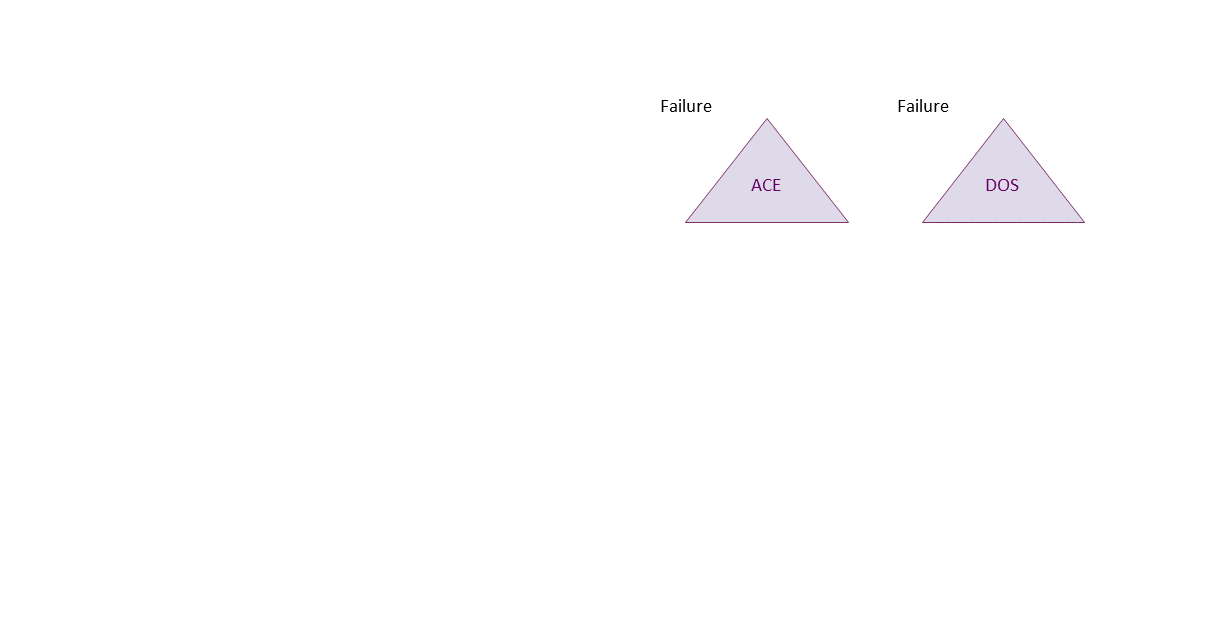BF Specification of CVE-2022-34835 Stack Buffer Overflow in Das U-Boot through 2022.07-rc5
-0.png)
Erroneous declaration of ‘nbytes’ as int leads to wrong argument type for the uint ‘length’ in ‘nbytes = length’, leading to a flipped sign, and under range negative ‘linebytes’, flipped and truncated to a large integer, allowing pointer reposition over bounds, which, when used in i2c_transfer() leads to stack buffer overflow. If exploited, this can lead to denial of service – program crash, and possibly arbitrary code execution.
|
| Class | Definition |
| DCL | Declaration (DCL) class – An object, a function, a type, or a namespace is declared or defined improperly. |
| TCV | Type Conversion (TCV) class – Data are converted or coerced into other type improperly. |
| TCM | Type Computation (TCM) class – An arithmetic expression (over numbers, strings, or pointers) is calculated improperly, or a boolean condition is evaluated improperly. |
| MAD | Memory Addressing (MAD) class – The pointer to an object is initialized, dereferenced, repositioned, or reassigned to an improper memory address. |
| MUS | Memory Use (MUS) class – An object is initialized, read, written, or cleared improperly. |
| Operation | Definition |
| Declare | Declare operation – Specify the name and type of an object; the name, return type, and parameters of a function; or the name and type parameters of a type. |
| Coerce | Coerce operation – Implicitly (forced by the Type System) convert the value of a passed in/out argument or the return into the corresponding parameter or return data type. (Type Coercion is known also as Type Juggling.) |
| Evaluate | Evaluate operation – Find the result of a Boolean condition (incl. comparison). |
| Reposition | Reposition operation – Change the pointer to another position inside its object. |
| Write | Write operation – Change the data value of an object in memory to another meaningful value. |
| Cause/Consequence | Definition |
| Code Bug | Code Bug type – An error in the implementation of an operation – proper operands over an improper operation. A first cause for the chain of weaknesses underlying a software security vulnerability. Must be fixed to resolve the vulnerability. |
| Erroneous Code | Erroneous Code bug - There is a coding error in the implementation of the operation. |
| Type | Type Fault/Error type – The set or range of allowed values of an entity is wrong or the operations allowed on them are wrong. |
| Wrong Type | Wrong Type fault/error – A data type range or structure is not correct. |
| Data Error/Fault | Data Fault/Error type – The data of an object has harmed semantics or inconsistent or wrong value. |
| Flipped Sign | Flipped Sign fault/error – Sign bit is overwritten from type related calculation. |
| Wrong Argument | Wrong Argument fault/error – Inaccurate input data value, i.e., non-verified for harmed semantics. |
| Under Range | Under Range fault/error – The data value is smaller than the lower range of its type. |
| Truncated Value | Truncated Value fault/error – The rightmost bits of a data value that won’t fit the data type size are cut off. |
| Wrong Size | Wrong Size fault/error – The value used as size or length (i.e., the number of elements) does not match an object's memory size or length (e.g., to limit a pointer reposition or index increment/decrement in a repetition statement). |
| Address Error/Fault | Address Fault/Error type – The address of an object is wrong. |
| Overbound Pointer | Overbound Pointer fault/error – Holds an address that is above the upper boundary of its object. |
| Memory Corruption/Disclosure Final Error | Memory Corruption/Disclosure final error type – An exploitable or undefined system behavior caused by memory addressing, allocation, use, or deallocation bugs. |
| Buffer Overflow | Buffer Overflow final error – Write data above the upper bound of an object (i.e., buffer overwrite). |
| Operation Attribute | Definition |
| Mechanism | Mechanism operation attribute type – Shows how the operation the operation with a bug or faulty operand is performed. |
| Simple | Simple operation attribute – The operation is via non-polymorphic types. |
| Pass Out | Pass Out operation attribute – The operation is via out or in/out arguments' values or a return value to a function/ operator. |
| Operator | Operator operation attribute – The operation is via a function with a symbolic name that implements a mathematical, relational or logical operation. |
| Pass In | Pass In operation attribute – The operation is via in arguments' values to a function/ operator. |
| Sequential | Sequential operation attribute – The operation is via iterating over the object elements. |
| Source Code | Source Code operation attribute type – Shows where the code of the operation with a bug or faulty operand resides within the software, firmware, or hardware. |
| Codebase | Codebase operation attribute – The operation is in the programmer's code - in the application itself. |
| Execution Space | Execution Space operation attribute type – Shows where the operation with a bug or faulty operand is executed and the privilege level at which it runs. |
| Bare-Metal | Bare-Metal operation attribute – The bugged code runs in an environment without privilege control. Usually, the program is the only software running and has total access to the hardware. |
| Operand Attribute | Definition |
| Name Kind | Name Kind operand attribute type – Shows what the entity with this name is. |
| Object | Object operand attribute – A memory region used to store data. |
| Type Kind | Type Kind operand attribute type – Shows what the data type composition is. |
| Primitive | Primitive operand attribute – A scalar data type that mimics the hardware units - e.g., int (long, short, signed), float, double, string, Boolean. A primitive data type is only language defined and is not built from other data types. |
| Name State | Name State operand attribute type – Shows what the stage of the entity name is. |
| Resolved | Resolved operand attribute – The name scope is known to the Type System. |
| Data Kind | Data Kind operand attribute type – Shows what the type or category of data is. |
| Numeric | Numeric operand attribute – A number – a sequence of digits. |
| Address State | Address State operand attribute type – Shows where the address is (i.e., its location) in the memory layout. |
| Stack | |
| Size Kind | Size Kind operand attribute type – Shows what is used as the size or length (i.e., the number of elements) of an object - e.g., as the limit for traversal over the elements. |
| Used | Used operand attribute – A supplied value to be used as the size or length (i.e., the number of elements) of an object. |
